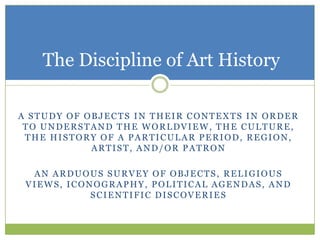
Art History 101. What is Art History?
- 1. The Discipline of Art History A STUDY OF OBJECTS IN THEIR CONTEXTS IN ORDER TO UNDERSTAND THE WORLDVIEW, THE CULTURE, THE HISTORY OF A PARTICULAR PERIOD, REGION, ARTIST, AND/OR PATRON AN ARDUOUS SURVEY OF OBJECTS, RELIGIOUS VIEWS, ICONOGRAPHY, POLITICAL AGENDAS, AND SCIENTIFIC DISCOVERIES
- 2. “Art history takes every object as a symptom of what produced it…In the hands of the art historian, the work seems to pass from opacity to transparency; from silence to speech.” We may only be able to understand the objective --Donald Preziosi of a piece by understanding the culture in which it was made. The magic word is CONTEXT.
- 3. The definition of “Art” changes Until the last 100 years, people commissioned works that would show an identified public a desired identity. “Art” had an agenda. In many periods, artists were more like construction workers than divinely inspired geniuses. So, Art History is often the study of patrons’ presented identities. It doesn’t matter what WE think about past works; we study these works to see how PATRONS wanted to be viewed.
- 4. The predominant questions are “How do we get from one period to another?”
- 5. And why do different periods privilege different images and styles?
- 6. And what are we expected to What are know and we recognize expected from the past to know in our own and culture today? recogniz e from the past in our Television, own Movies, Advertising,, culture Videos, today? Cartoons, etc…
- 7. So we study history and culture to understand people’s objects. In order to achieve that goal, Art History studies the relationship a work has to the culture in which it was made by exploring: Contemporary Historical Events Literature Philosophy Scientific Discoveries Music Art History is Interdisciplinary
- 8. The Language of Art History ART HISTORY REQUIRES A NEW VOCABULARY SURROUNDING: CHRONOLOGY STYLE SUBJECT FORMAL ANALYSIS AND BIAS
- 9. Chronology When was the work created? What other facets of culture—music, philosophy, politics, literature, religion, science—influenced the creation of the work? What can the piece tell us about the status of women in a particular year? What did people believe the role of the gods were in a particular generation?
- 10. Artist and Patron Who created the work? What is her/his story? ◦ Biographical Analysis Who commissioned/purchased the work? For what agenda? ◦ Political Propaganda? ◦ To promote a reputation of wealth or power? ◦ To sustain life after death? ◦ Criticism of respective culture ◦ Self-expression What other facets of culture—music, philosophy, politics, literature, religion, science—influenced the commissioning of the work?
- 11. Style Period Style—those characteristics particular to a specific time and a specific culture ◦ Greco-Roman ◦ Islamic Regional—those characteristics particular to a specific provenance ◦ Egyptian ◦ Mesoamerican Personal Style—those characteristics particular to an individual artist and his/her techniques MICHELANGELO as different from CARAVAGGIO In 101 we will know fewer artists than in 102 How are these styles determined by the cultures in which they arise?
- 12. What stylistic clues help us recognize these regions or periods? EGYPT: Upright pose, Diorite ANCIENT GREECE: Marble, material, eternally youthful visage, Contrapposto, Nudity, rational Horus on Neck proportions
- 13. Subject Iconography—the writing of images VISUAL CONTENT SYMBOLS ATTRIBUTES PERSONIFICATIONS Helps us “read” the image presented HINT: Don’t Ignore the Obvious.
- 14. What iconography helps us recognize this subject? SUBJECT: Maesta ICNOGRAPHY: Man-Child on her Lap (Jesus) Throne Surrounded by Angels Red and Blue Robes Mantle Halo Inscription below (but most people would have been illiterate)
- 15. Formal Analysis These elements will often help us understand why we react to a particular piece the way we do Composition Medium/Technique Line, Color, Texture Mass, Volume Perspective Linear, Atmospheric Perspective and Foreshortening Proportion/Disproportion Hierarchy of Scale
- 16. Bias How we interpret meaning is directly influenced by how we identify ourselves and what we (unconsciously) assume about others ◦ Gender identity ◦ Age ◦ Ethnicity ◦ Socio-Economic Class ◦ Education ◦ Religious Creed ◦ Sexual Orientation Being aware of our biases (we all have many), we can be more informed about what we see REMEMBER, bias is neither good nor bad; it just is.
- 17. Which is the “correct” portrait? Te Pehi Kupe, Self Portrait , John Sylvester, Portrait of Te 1826 Pehi Kupe, 1826 It depends on what we privilege--self-identification or « naturalism. »
- 18. IN SUMMARY Art History is an We are going to use the uncovering of historical tools of: changes as seen in works Chronology of art Artist and Patron Art History is Style interdisciplinary Iconography Formal Analysis And we are going to be as conscious as we can of our biases
- 19. The Discipline of Art History A STUDY OF OBJECTS IN THEIR CONTEXTS IN ORDER TO UNDERSTAND THE WORLDVIEW, THE CULTURE, THE HISTORY OF A PARTICULAR PERIOD, REGION, ARTIST, AND/OR PATRON AN ARDUOUS SURVEY OF OBJECTS, RELIGIOUS VIEWS, ICONOGRAPHY, POLITICAL AGENDAS, AND SCIENTIFIC DISCOVERIES